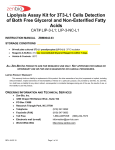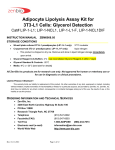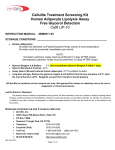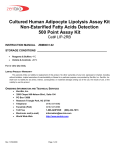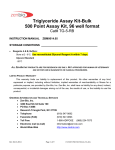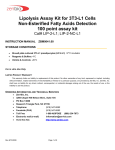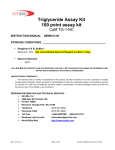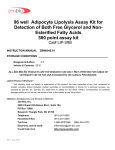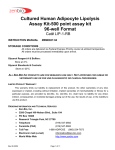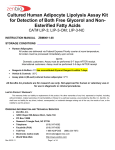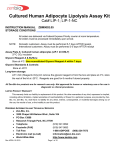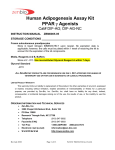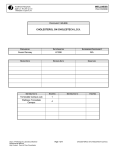Download 96-well Serum/Plasma Fatty Acid and Glycerol Kit for - Zen
Transcript
96-well Serum/Plasma Fatty Acid and Glycerol Kit for the Detection of Both Non-Esterified Fatty Acids and Free Glycerol Cat# GFA-1 INSTRUCTION MANUAL ZBM0033.05 STORAGE CONDITIONS Reagents & Buffers: Blank assay plates (96-well): 4°C Use reconstituted Glycerol Reagent A within 7 days. Room Temperature All Zen-Bio Inc products are for research use only. Not approved for human or veterinary use or for use in diagnostic or clinical procedures. LIMITED PRODUCT WARRANTY This warranty limits our liability to replacement of this product. No other warranties of any kind, expressed or implied, including without limitation, implied warranties of merchantability or fitness for a particular purpose, are provided by Zen-Bio, Inc. Zen-Bio, Inc. shall have no liability for any direct, indirect, consequential, or incidental damages arising out of the use, the results of use, or the inability to use this product. ORDERING INFORMATION AND TECHNICAL SERVICES Zen-Bio, Inc. 3200 East NC-54 Suite 100 PO Box 13888 Research Triangle Park, NC 27709 Telephone Facsimile (FAX) (919) 547-0692 (919) 547-0693 Toll Free Electronic mail (e-mail) 1-866-ADIPOSE (866)-234-7673 [email protected] World Wide Web http://www.zen-bio.com Rev 08.14.2013 Page 1 of 10 INTRODUCTION This kit is designed to accurately determine the amount of free fatty acid and glycerol present in blood serum or plasma of humans, mice, rats, and other animals in a 96-well format for increased throughput analysis. Blood can be collected in plain evacuated tubes or in the presence of common anti-coagulants: sodium citrate, ammonium oxalate and EDTA. NOTE: Heparin or Heparinized tubes should not be used because this will generate inaccurate readings. Serum should be separated from clotted blood by centrifugation as soon as possible and may be stored frozen (-20°C) prior to analysis. PRINCIPLES OF THE ASSAYS Detection of Non-Esterified Fatty Acids (Free Fatty Acids; FFA) Assessment of serum fatty acids is through a coupled reaction to measure non-Esterified fatty acids (NEFA). The initial step, carried out by acyl-CoA synthetase (ACS), produces fatty acyl-CoA thiol esters from the NEFA, ATP, Mg, and CoA in the reaction. ACS The acyl-CoA derivatives react with oxygen in HCOOH + ATP + CoA Acyl-CoA + AMP + PPi (NEFA) the presence of acyl-CoA oxidase (ACOD) to produce hydrogen peroxide. Hydrogen ACOD Acyl-CoA + O2 2,3-trans-Enoyl-CoA + H2O2 peroxide in the presence of peroxidase (POD) allows the oxidative condensation of 3methyl-N-ethyl-N-(-hydroxyethyl)-aniline with CH NH N N 4-aminoantipyrine which forms a purple C H OH N O CH POD N product that absorbs light at 550nm. This 2H O + N + O N N + 4H O C H OH allows the concentration of NEFA to be determined from the optical density measured at 540 - 550nm. 2 2 2 5 2 4 2 5 2 4 2 2 Detection of Free Glycerol Glycerol present in sample is phosphorylated by adenosine triphosphate (ATP) forming glycerol-1phosphate (G-1-P) and adenosine-5’-diphosphate (ADP) in the reaction catalyzed by glycerol kinase. G-1-P is then oxidized by glycerol phosphate oxidase to dihydroxyacetone phosphate (DAP) and hydrogen peroxide (H2O2). A quinoneimine dye is produced by the peroxidase catalyzed coupling of 4-aminoantipyrine (4-AAP) and sodium N-ethytl-N-(3-sulfopropyl)m-anisidine (ESPA) with H2O2, which shows an absorbance maximum at 540nm. The increase in absorbance at 540nm is directly proportional to glycerol concentration of the sample. GLYCEROL + ATP G-1-P + ADP G-1-P + O2 DAP + H2O2 H2O2 +4-AAP + ESPA Rev 08.14.2013 Page 2 of 10 Quinoneimine dye + H2O ITEMS INCLUDED IN THE KIT ITEM Assay Plate, blank Dilution Buffer FFA Standard FFA Diluent A FFA Diluent B FFA Reagent A DESCRIPTION 96-well assay plate, blank 50 ml 1mM Stock. See page 4 for standard curve preparation Glycerol Reagent A (cat# RGTA-10) water prior to use. Use within 7 days. Tray Glycerol standard For multi-channel pipetters, clear polyvinyl Glycerol @ 1mM [Dilute with 400 l (cat# LIP-GLYSTAN) Dilution Buffer to make the 200 M UNIT QTY STORAGE PLATE 3 1 1 ----4°C 4°C 4°C 4°C 4°C BOTTLE PINK 100 l / VIAL 10.5 ML 5.5 ML YELLOW BOTTLE 1 1 1 PINK BOTTLE 1 4°C --- BOTTLE 1 4°C CLEAR EACH 2 ----- ORANGE 100 l / 1 -20°C AMBER YELLOW Reconstitute using 10.5 ml FFA Diluent A. Discard remainder after 10days Reconstitute using 5.5 ml FFA Diluent B. Discard remainder after 10 days Reconstitute with 11.0 ml deionized FFA Reagent B Cap Color ----- VIAL glycerol standard; see page 5 for recommended dilution scheme] Other equipment/reagents required but not provided with the kit: Multi-channel Pipet , single channel pipet and pipet tips Plate reader with a filter of 540 nm Incubator at 37oC Large gauge needle Tubes for diluting standards Rev 08.14.2013 Page 3 of 10 ASSAY PROCEDURE A. DETECTION OF NON-ESTERIFIED FATTY ACIDS 1. Prepare the NEFA standard curve using the FFA STANDARD SOLUTION as follows: Briefly spin down the contents of the free fatty acid standard tube. Standards are: 0, 1.4, 4.1, 12.3, 37, 111, and 333 M fatty acid. Prepare as follows: The kit standard solution is the 1.0 mM standard. Pipette 120 l of Dilution Buffer into 6 tubes (not provided). Pipette 60 l of the FFA Standard Stock into a tube labeled 333 µM. Prepare a dilution series as depicted below. Mix each new dilution thoroughly before proceeding to the next. The Dilution Buffer alone serves as the zero standard. 60 l 60 l 60 l 60 l 60 l 60 l Std FFA Std 333 M 111 M 37 M 12.3 M 4.1 M 1.4 M Note: The above dilution series generates enough volume to perform the standard curve in duplicate. If you wish to perform the standard curve in duplicate, please note that seven fewer data points can be assayed with this kit. 2. Also at this time prepare the FFA Reagent A by adding 10.5 ml FFA Diluent A per bottle and gently inverting. DO NOT VORTEX! Store any remaining solution at 2-8C; it is stable for 10 days after reconstitution refrigerated (2-8C). 3. Add 5 l (or 1 - 10 l) of serum or plasma to a well of Plate A. Add dilution buffer to each well to total 50 l including serum or plasma sample. THIS RESULTS IN A 10x DILUTION OF YOUR SAMPLE (5 l in 50 l). Add 50 l of each standard to empty wells (use PLATE B if necessary). 4. Add the reconstituted FFA Reagent A to one of the disposable trays provided in the kit. Add 100 l of FFA Reagent A to each well. Gently shake the plate to ensure mixing. Place in a 37 oC incubator for 10 minutes. 5. Prepare the FFA Reagent B by adding 5.5 ml FFA Diluent B per bottle and gently inverting. DO NOT VORTEX! Store any remaining solution at 2-8C; it is stable for 10 days after reconstitution refrigerated (2-8C). 6. Add the reconstituted FFA Reagent B to the other disposable tray provided in the kit. Add 50 l of FFA Reagent B to each well. Gently shake the plate to ensure mixing. Place in a 37 oC incubator for 10 minutes. Rev 08.14.2013 Page 4 of 10 7. Allow the plate to equilibrate to room temperature for 5 minutes. During this time, ensure that there are no bubbles in the solution mixture. Use a large gauge needle or clean pipet tip to pop any bubbles as this will result in inaccurate absorbance readings. 8. The optical density of each well is then measured at 540 nm. B. DETECTION OF FREE GLYCEROL 1. Prepare the glycerol standards as follows: Briefly spin down the contents of the glycerol standard tube before reconstitution. Pipette 400 l of Dilution Buffer into the 1 mM glycerol standard tube provided and mix well by vortexing. This produces a diluted stock glycerol standard of 200 M. Pipette 250 l of dilution buffer into 6 tubes (not provided). Using the newly diluted stock glycerol solution, prepare a dilution series as depicted below. Mix each new dilution thoroughly before proceeding to the next. The 200 M stock dilution serves as the highest standard, and the dilution buffer serves as the zero standard. 400 l 250 l 250 l 250 l 250 l 250 l 250 l Dilution Buffer Std 200 M 100 M 50 M 25 M 12.5 M 6.25 M 3.125 M Note: The above dilution series generates enough volume to perform the standard curve in duplicate. If you wish to perform the standard curve in duplicate, please note that eight fewer data points can be assayed with this kit. 2. Also at this time prepare the Glycerol Reagent A by adding 11.0 ml room temperature deionized water per bottle and gently invert. DO NOT VORTEX! Use a pipet to ensure that the powder is completely dissolved. Store at room temperature. If using a Reagent A solution previously prepared and stored at 28C, also bring to room temperature. Make sure there is enough Reagent A from one solution to treat all the points in the assay. It may be necessary to combine solutions. Store in a light protected bottle. Reconstituted Glycerol Reagent A is stable for 7 days refrigerated (2-8C); store any remaining solution refrigerated (2-8C). 3. Add 20 l (or 10 - 25 l) of serum or plasma to a well of a blank plate for assessment of free glycerol. Add 30l of dilution buffer to each well to total 50 l including serum or plasma sample. THIS RESULTS IN A 2.5x DILUTION OF YOUR SAMPLE (20 l in 50 l). Add 50 l of each standard to empty wells (use another plate, if necessary). 4. Add the reconstituted Glycerol Reagent A solution to one of the disposable trays provided in the kit. Add 50 l of Reagent A to each well of the glycerol plate. Gently, pipet up and down once to mix. Pop the Rev 08.14.2013 Page 5 of 10 bubbles using a large gauge needle or a clean pipet tip. The plate is then incubated at 25 oC (room temperature) for 15 minutes. 5. The optical density of each well is then measured at 540 nm. FATTY ACID STANDARD CURVE Generate standard curve: see example below [DO NOT use this standard curve to generate your data. This is an example.] Subtract the OD value of the 0M standard from all OD values including the standard curve. . Note: 1mM standard is commonly omitted from analysis due to lack of linearity between 333 M and 1mM. Optionally, a 4-parameter fit may be used to calculate standard curve. ODblank ODblank Avg ODblank uM FFA OD OD 0 0.05 0.048 1.4 0.051 0.053 0.002 0.004 0.003 4.1 0.056 0.058 0.007 0.009 0.008 12.3 0.070 0.075 0.021 0.026 0.024 37 0.119 0.122 0.070 0.073 0.072 111 0.274 0.277 0.225 0.228 0.227 333 0.689 0.750 0.640 0.701 0.671 Slope 0.002 Intercept -0.001 R 2 0.049 1.000 y = observed O.D. minus the blank x = concentration of FFA in M To calculate x for each y, (i.e. to change the observed O.D. into FFA concentration) use the following equation: y=(slope) times (x) plus intercept y=mx+b so x=(y-b)/m x=(y – (-0.001))/0.002 where 0.002= slope of the line and -0.001= y intercept. Be careful to enter the proper sign for the y intercept value as it may be a negative number. Data are expressed as M free fatty acids released. OPTION: express data as Fold induction over appropriate vehicle Fold induction = M free fatty acids SAMPLE M free fatty acids VEHICLE The R2 value should be equal or greater then 0.98 for the standard curve to be valid. Any R 2 values below 0.98 must have the standard curve run again. Rev 08.14.2013 Page 6 of 10 GLYCEROL STANDARD CURVE Generate standard curve: see example below [DO NOT use this standard curve to generate your data. This is an example.] Subtract the OD value of the 0M standard from all OD values including the standard curve. uM glycerol ODblank ODblank Avg ODblank OD OD 0 0.044 0.041 3.125 0.054 0.053 0.012 0.011 0.011 6.25 0.062 0.063 0.020 0.021 0.020 12.5 0.083 0.084 0.041 0.042 0.041 25 0.126 0.125 0.084 0.083 0.083 50 0.205 0.208 0.163 0.166 0.164 100 0.372 0.374 0.330 0.332 0.331 200 0.698 0.697 0.656 0.655 0.655 Slope 0.003 Intercept 0.001 R 2 0.043 1.000 y = observed O.D. minus the blank x = concentration of glycerol in M To calculate x for each y, (i.e. to change the observed O.D. into glycerol concentration) use the following equation: y=(slope) times (x) plus intercept y=mx+b so x=(y-b)/m x=(y – (0.001))/0.003 where 0.003= slope of the line and 0.001= y intercept. Be careful to enter the proper sign for the y intercept value as it may be a negative number. Any OD values greater than the highest standard (200 M) should be suspect. The compound should be re-assayed using a lower dose of the compound at treatment OR a dilute solution of the condition medium at the time of the assay. The R2 value should be equal or greater than 0.98 for the standard curve to be valid. Any R2 values below 0.98, must have the standard curve run again. Data are expressed as M glycerol. REMEMBER TO ACCOUNT FOR THE DILUTION FACTOR IN STEP 3. Rev 08.14.2013 Page 7 of 10 FREQUENTLY ASKED QUESTIONS: 1. Can I buy the reagents separately? The Glycerol Standard, cat# LIP-GLYSTAN, Free fatty Acid Standard, cat# FFA-STAN and Glycerol Reagent A, cat# RGTA-10 are sold separately. LIP2/3 Assay Buffer, Free Fatty Acid Reagents and Diluents A and B are not sold separately. 2. I need to know the concentration of the BSA in the Assay Buffer? ZenBio, Inc does not provide the concentrations of the components of our media and buffers. If knowledge of the BSA concentration is critical to your experiment, you may order Assay Buffer WITHOUT BSA for no additional charge. Please note it on your order. 3. What is the Free Fatty Acid standard? Free Fatty Acid standard (cat# FFA-STAN) is oleic acid in an aqueous buffer. 4. I have more samples plus standards to run than can fit on 1 96 well plate. Can I compare data obtained from multiple plates? The lipolysis kit is designed for the assay of a single plate. You may purchase 2 kits of the same lot number. You may then use one plate that includes the blank, vehicle(s), and positive and negative controls. The second plate may then be used for the remainder of your samples assayed. In order to obtain comparable data, both plates must be assayed on the same day using kits and cells from the same lot number. An additional blank assay plate is provided for the assay of glycerol standards. Rev 08.14.2013 Page 8 of 10 APPENDIX A: PLATE LAYOUT A B C D E F G H 1 2 3 4 5 6 7 8 9 10 11 12 Rev 08.14.2013 Page 9 of 10 APPENDIX B: PROCEDURE FLOWCHART NEFA Detection Plate A Sample Add 5 l/well test sample and 45 l/well dilution buffer to one of the blank assay plates provided. Add 50 l/well diluted standard curve to empty wells. 5 l OOOOOOOOOOOO OOOOOOOOOOOO OOOOOOOOOOOO OOOOOOOOOOOO OOOOOOOOOOOO Plate B Reconstitute FFA Reagent A using Diluent A. Add 100l/well. Incubate 10 minutes @ 37C. Reconstitute FFA Reagent B using Diluent B. Add 50l/well. Incubate 10 minutes @ 37C. 100l/well FFA Reagent A OOOOOOOOOOOO OOOOOOOOOOOO OOOOOOOOOOOO OOOOOOOOOOOO OOOOOOOOOOOO 50l/well FFA Reagent B OOOOOOOOOOOO OOOOOOOOOOOO OOOOOOOOOOOO OOOOOOOOOOOO OOOOOOOOOOOO OOO OOO OOO OOO OOO An additional plate may be necessary for the assay of standards. OOO OOO OOO OOO OOO Place at room temp. for 5 minutes. Pop any bubbles in each well using a clean pipet tip or large gauge needle. Measure the optical density of each well at 540 nm using a spectrophotometer plate reader. Reminder: Sample was diluted in Step 3 Glycerol Detection Add 20 l/well test sample and 30 l/well dilution buffer to one of the blank assay plates provided. Add 50 l/well diluted standard curve to empty wells. Plate A Sample 20 l OOOOOOOOOOOO OOOOOOOOOOOO OOOOOOOOOOOO OOOOOOOOOOOO OOOOOOOOOOOO Plate B Reconstitute Glycerol Reagent A. Add 50l/well. Incubate 15 minutes @ room temperature. Measure the optical density of each well at 540 nm using a spectrophotometer plate reader. Reminder: Sample was diluted in Step 3 Rev 08.14.2013 Page 10 of 10 OOOOOOOOOOOO OOOOOOOOOOOO OOOOOOOOOOOO OOOOOOOOOOOO OOOOOOOOOOOO 50l/well Glycerol Reagent A OOO OOO OOO OOO OOO










